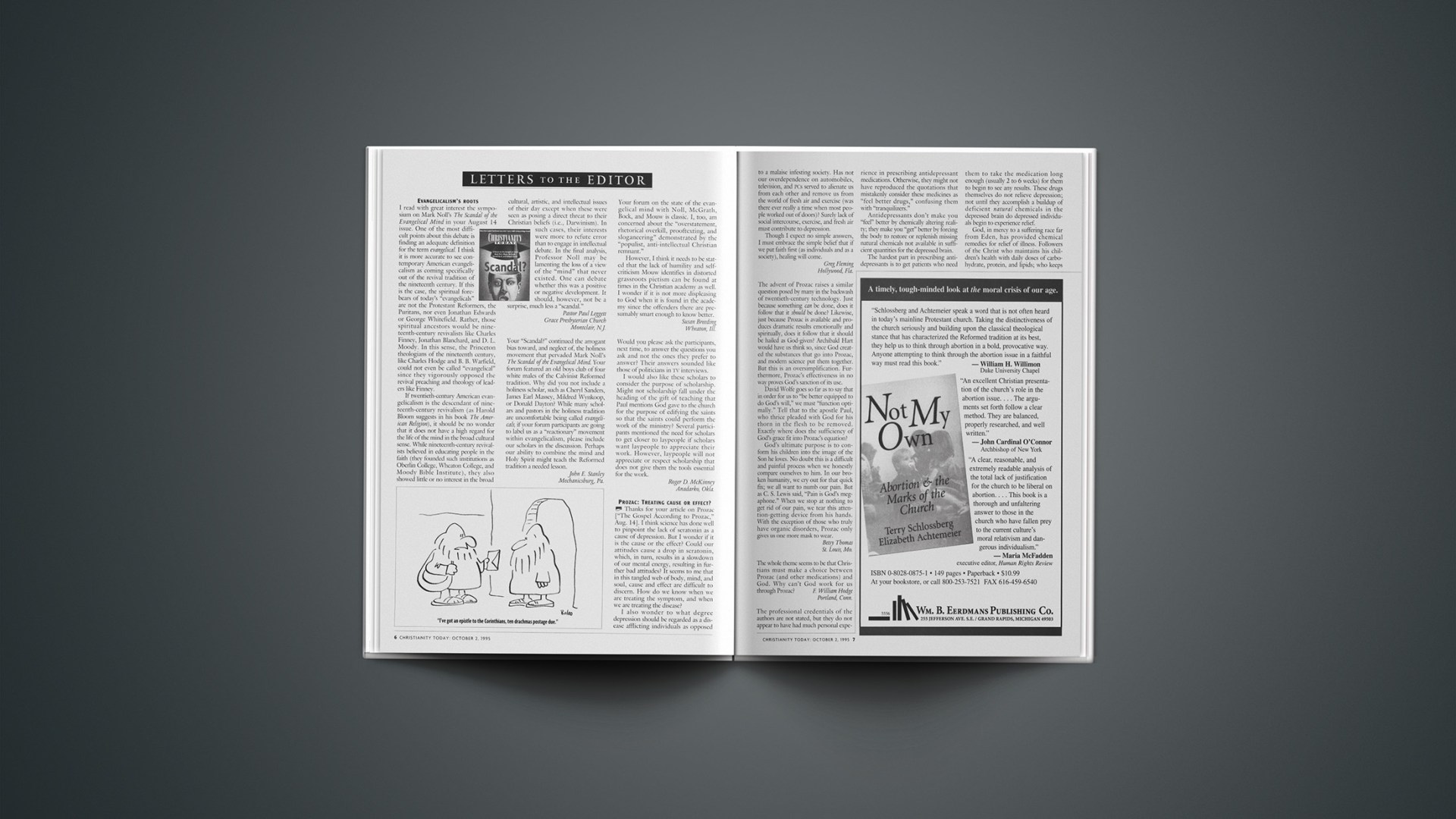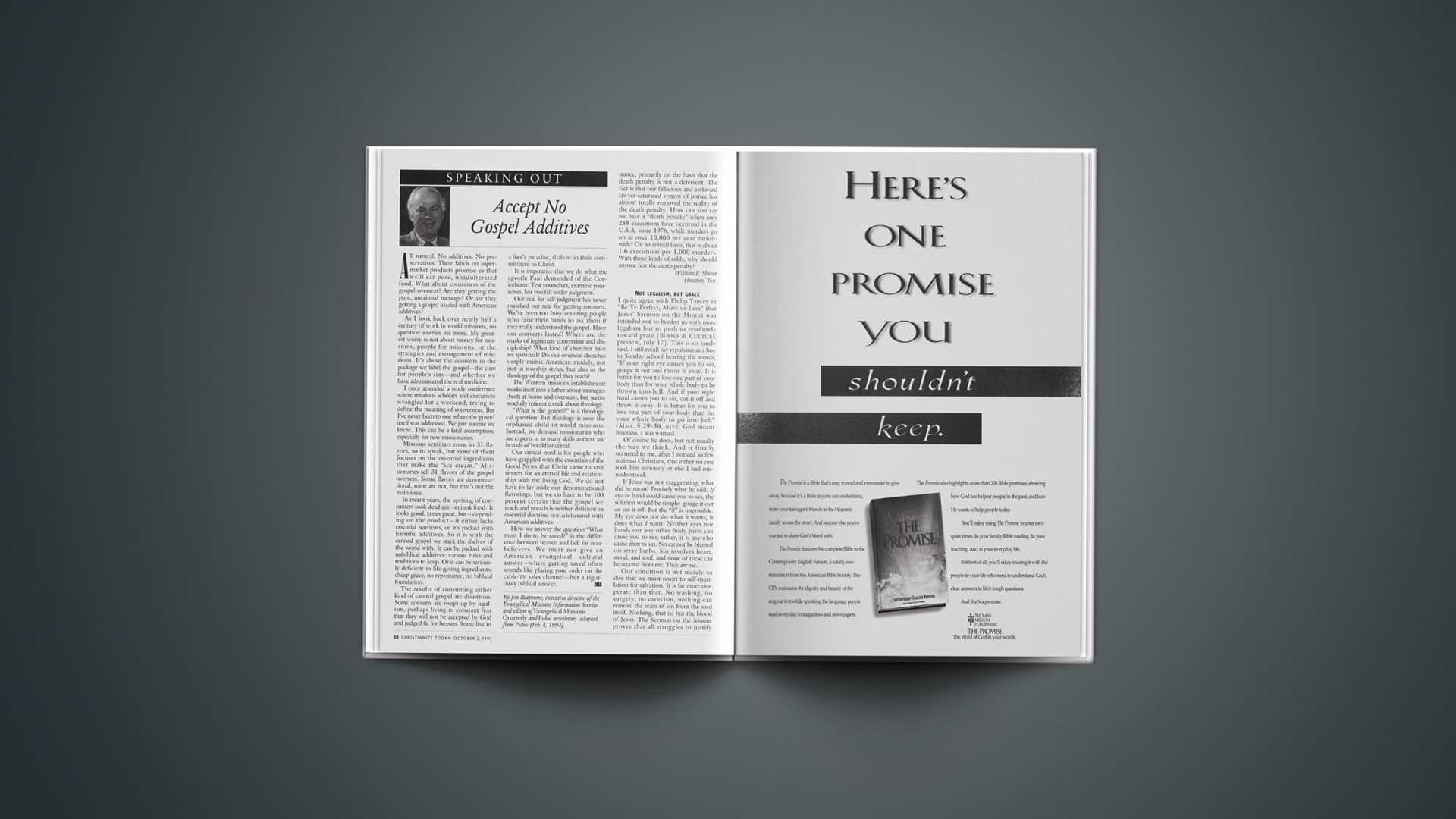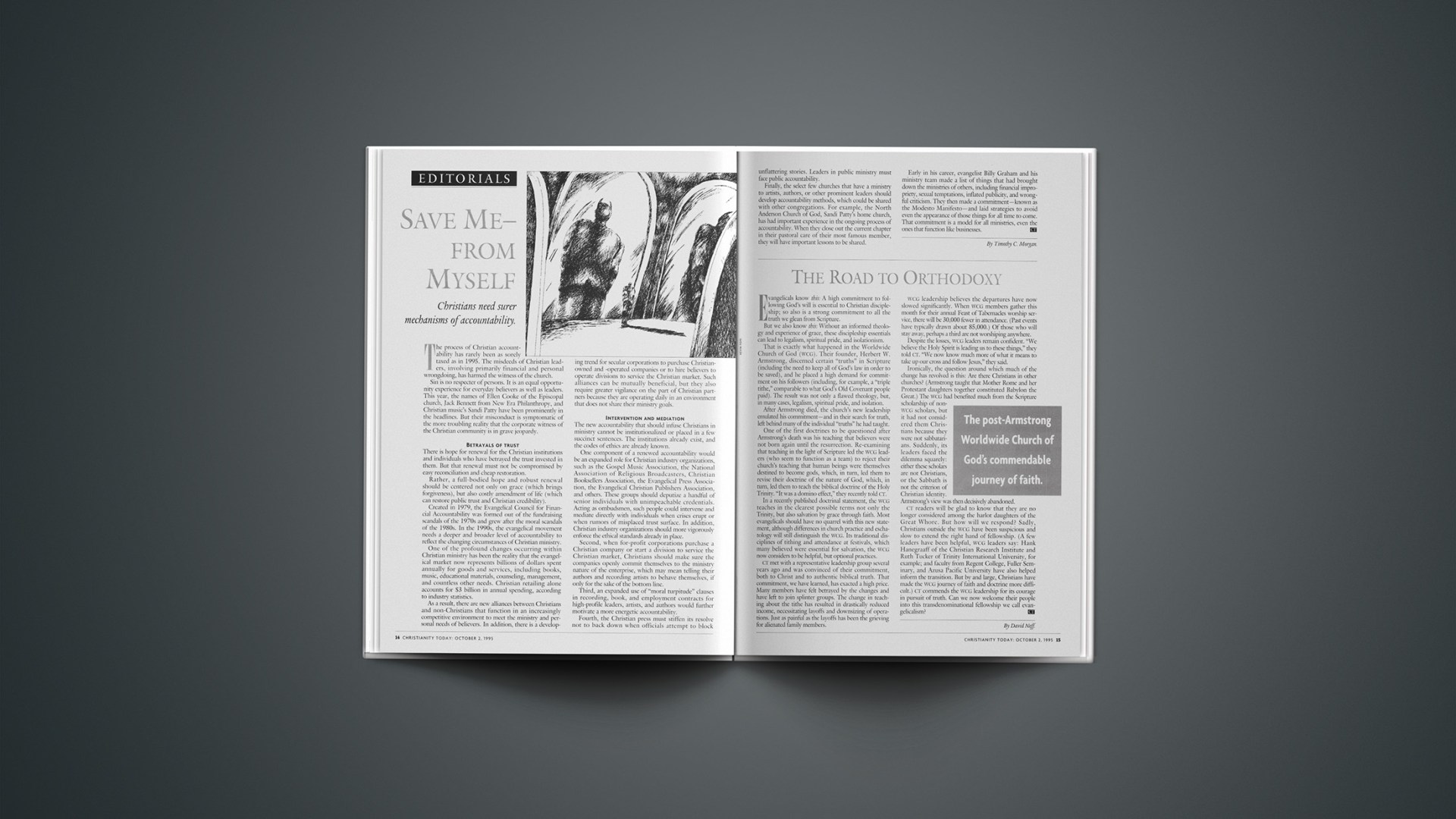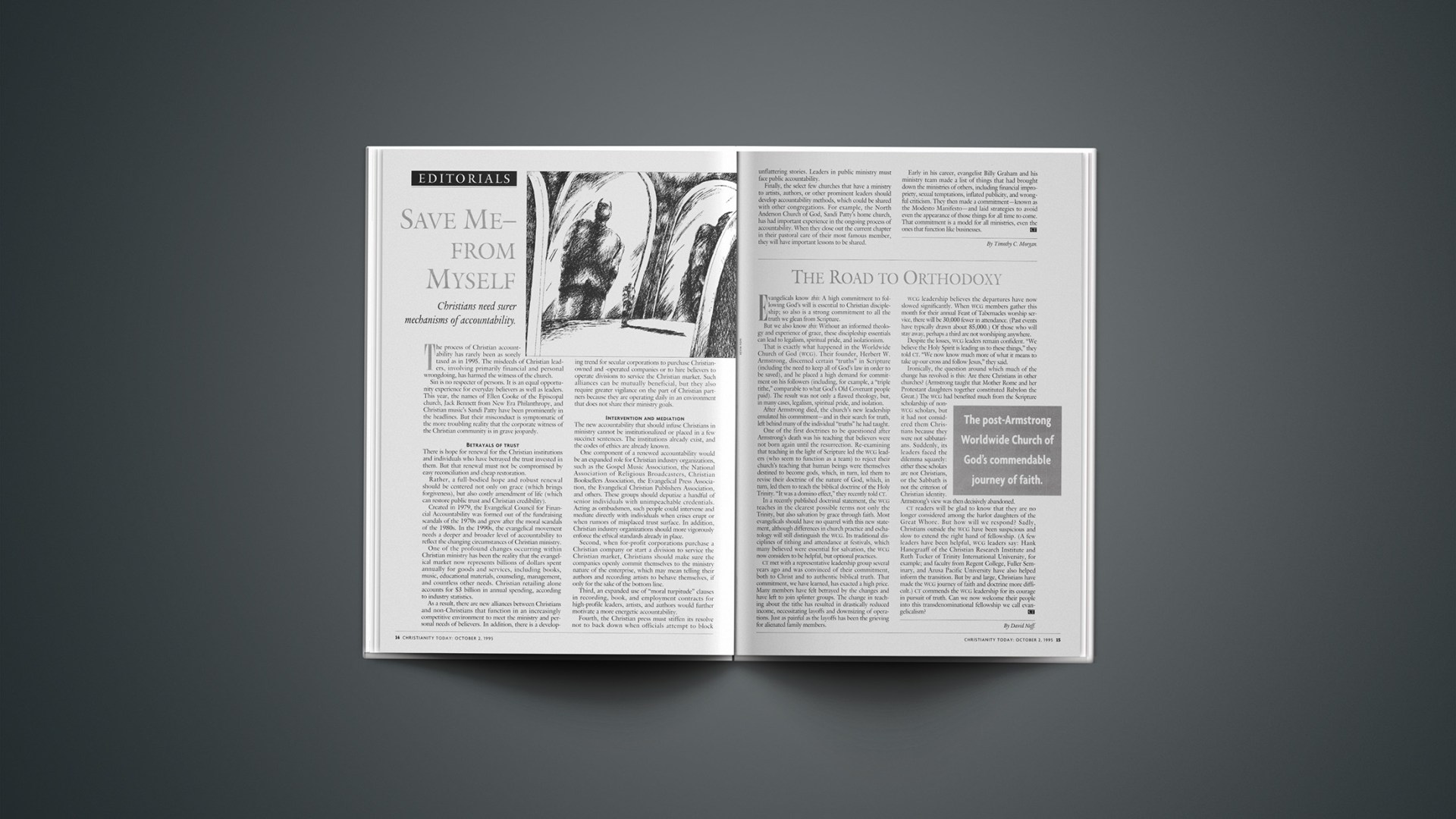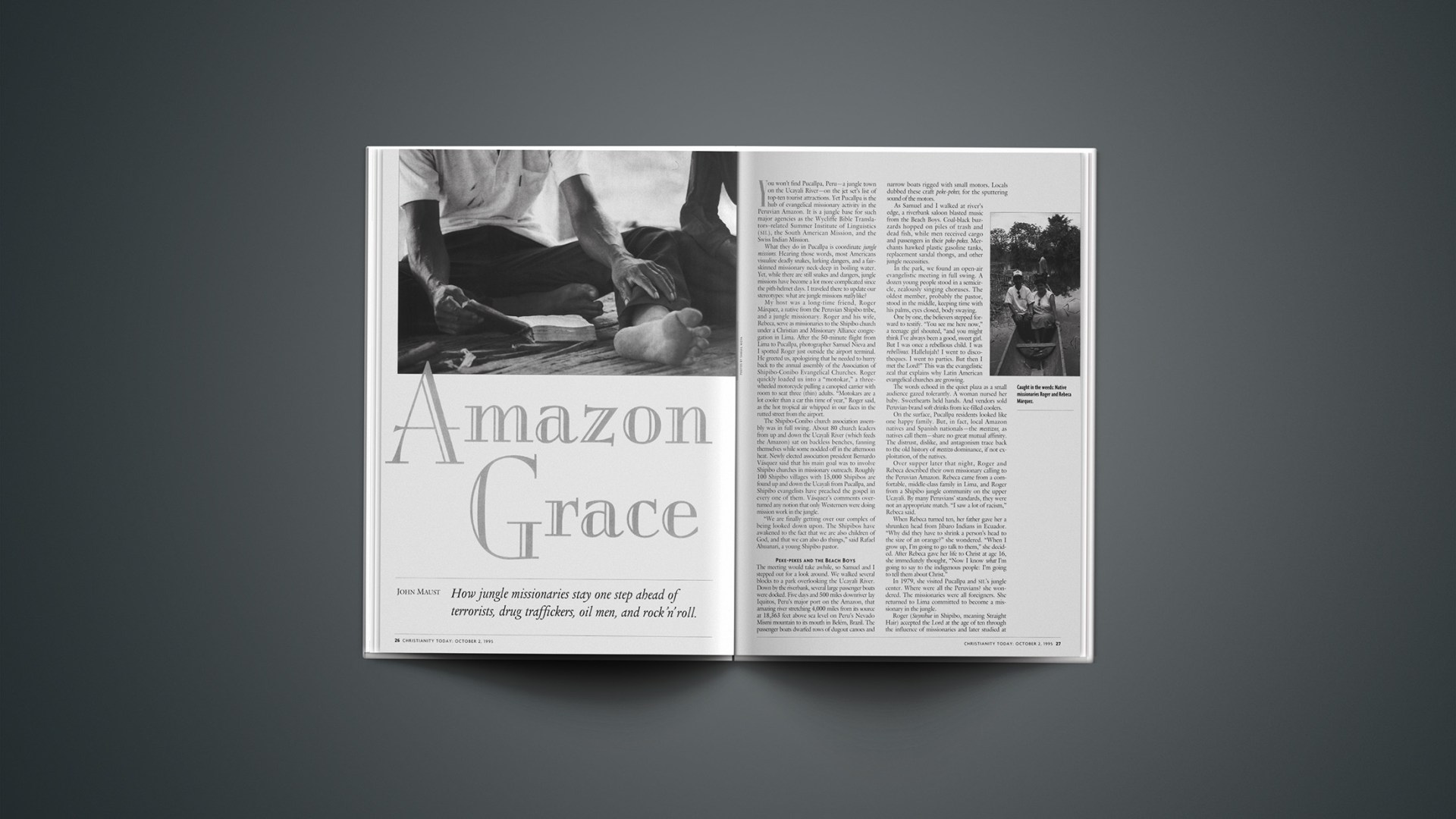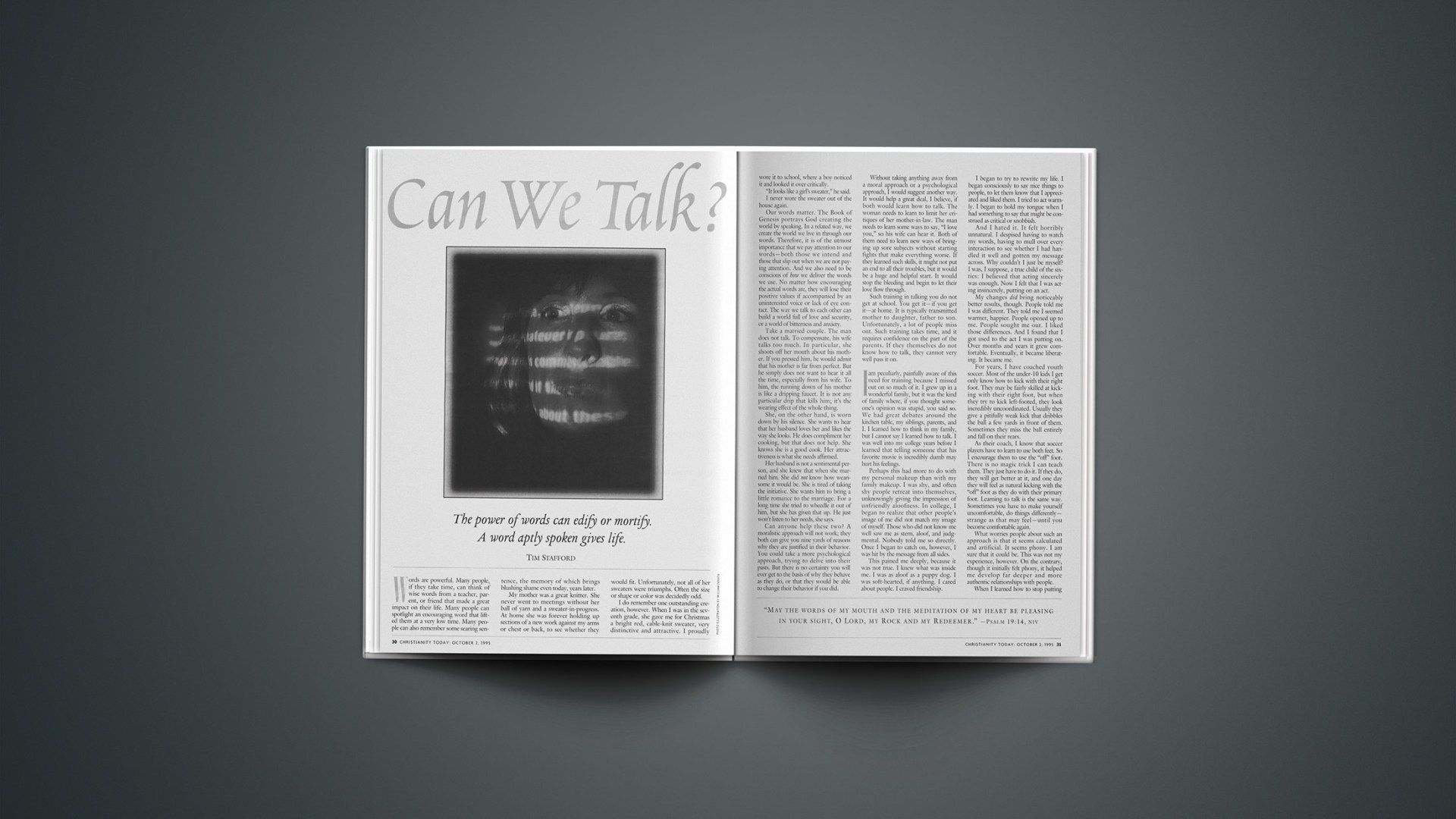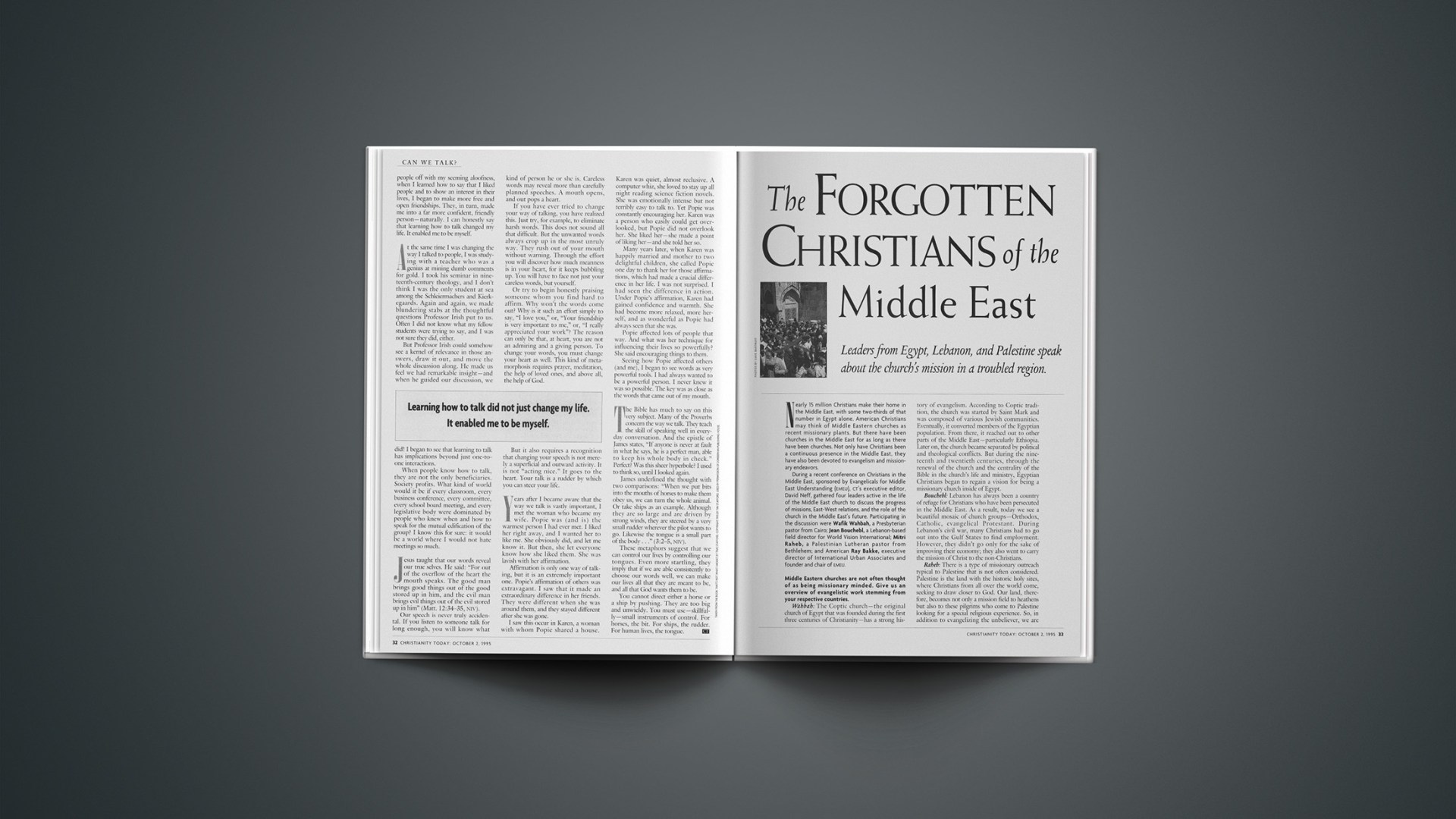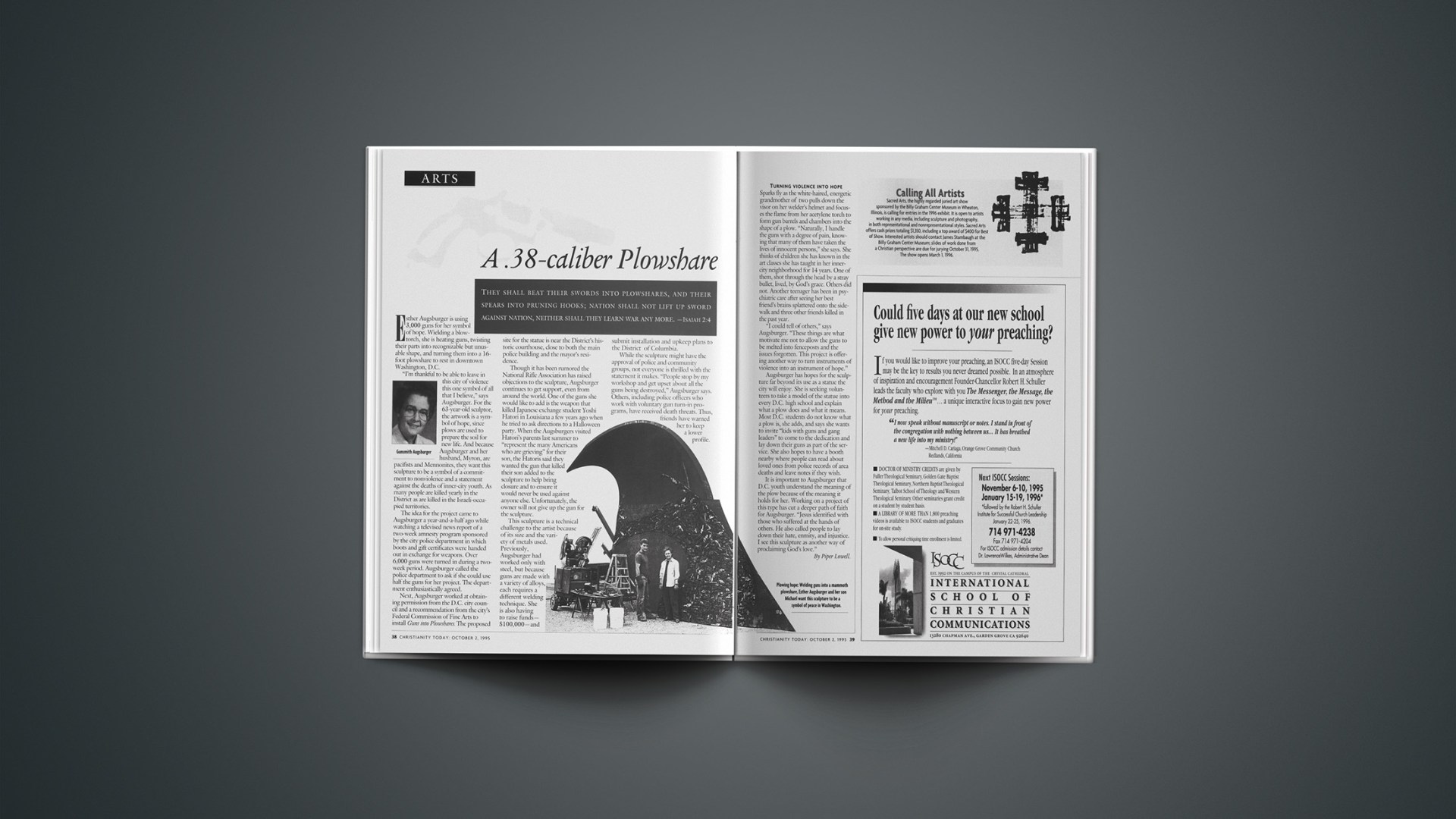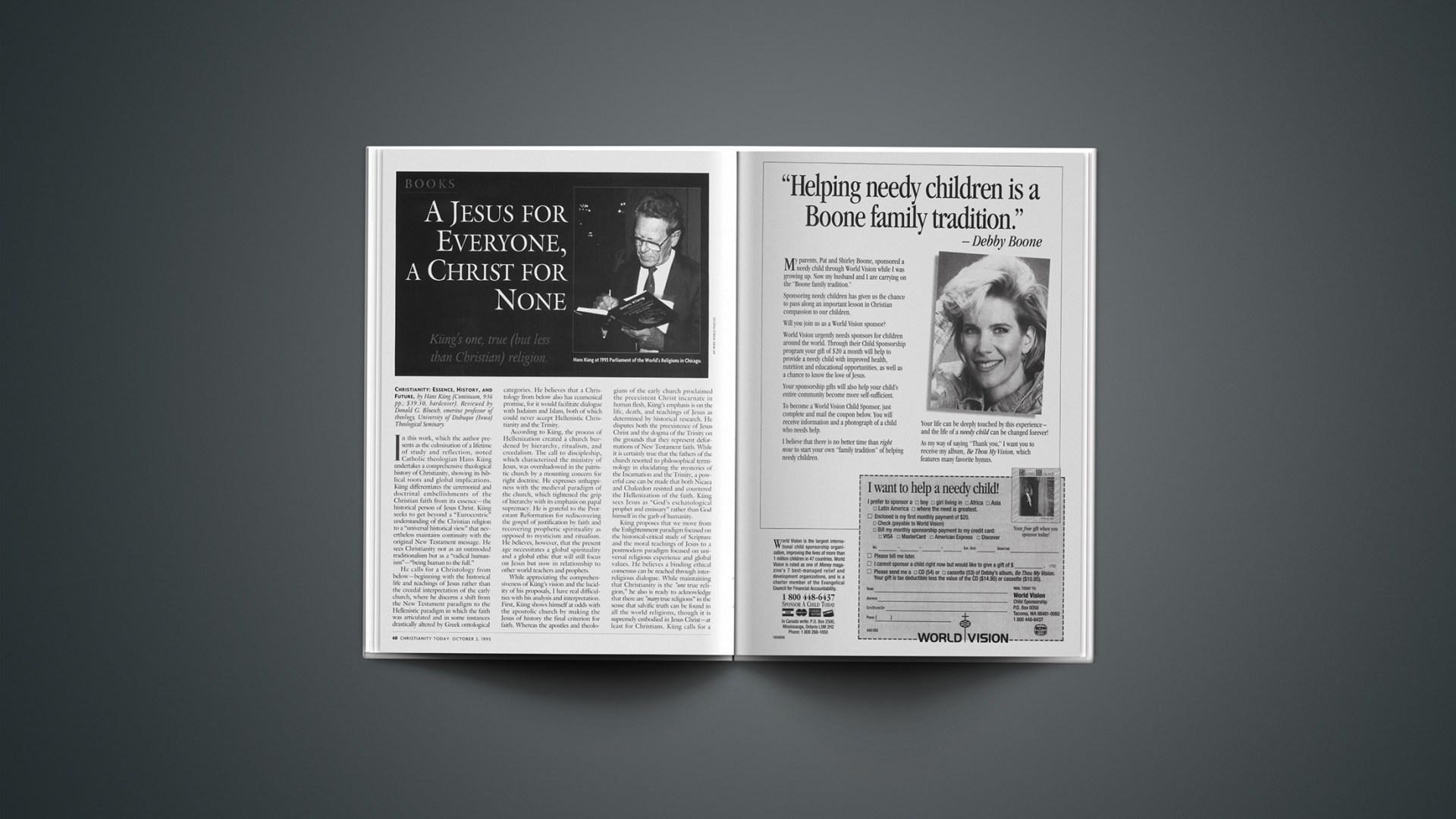EVANGELICALISM’S ROOTS
I read with great interest the symposium on Mark Noll’s “The Scandal of the Evangelical Mind” in your August 14 issue. One of the most difficult points about this debate is finding an adequate definition for the term evangelical. I think it is more accurate to see contemporary American evangelicalism as coming specifically out of the revival tradition of the nineteenth century. If this is the case, the spiritual forebears of today’s “evangelicals” are not the Protestant Reformers, the Puritans, nor even Jonathan Edwards or George Whitefield. Rather, those spiritual ancestors would be nineteenth-century revivalists like Charles Finney, Jonathan Blanchard, and D. L. Moody. In this sense, the Princeton theologians of the nineteenth century, like Charles Hodge and B. B. Warfield, could not even be called “evangelical” since they vigorously opposed the revival preaching and theology of leaders like Finney.
If twentieth-century American evangelicalism is the descendant of nineteenth-century revivalism (as Harold Bloom suggests in his book “The American Religion”), it should be no wonder that it does not have a high regard for the life of the mind in the broad cultural sense. While nineteenth-century revivalists believed in educating people in the faith (they founded such institutions as Oberlin College, Wheaton College, and Moody Bible Institute), they also showed little or no interest in the broad cultural, artistic, and intellectual issues of their day except when these were seen as posing a direct threat to their Christian beliefs (i.e., Darwinism). In such cases, their interests were more to refute error than to engage in intellectual debate. In the final analysis, Professor Noll may be lamenting the loss of a view of the “mind” that never existed. One can debate whether this was a positive or negative development. It should, however, not be a surprise, much less a “scandal.”
– Pastor Paul Leggett
Grace Presbyterian Church
Montclair, N.J.
Your “Scandal?” continued the arrogant bias toward, and neglect of, the holiness movement that pervaded Mark Noll’s “The Scandal of the Evangelical Mind.” Your forum featured an old boys club of four white males of the Calvinist Reformed tradition. Why did you not include a holiness scholar, such as Cheryl Sanders, James Earl Massey, Mildred Wynkoop, or Donald Dayton? While many scholars and pastors in the holiness tradition are uncomfortable being called evangelicals, if your forum participants are going to label us as a “reactionary” movement within evangelicalism, please include our scholars in the discussion. Perhaps our ability to combine the mind and Holy Spirit might teach the Reformed tradition a needed lesson.
– John E. Stanley
Mechanicsburg, Pa.
Your forum on the state of the evangelical mind with Noll, McGrath, Bock, and Mouw is classic. I, too, am concerned about the “overstatement, rhetorical overkill, prooftexting, and sloganeering” demonstrated by the “populist, anti-intellectual Christian remnant.”
However, I think it needs to be stated that the lack of humility and self-criticism Mouw identifies in distorted grassroots pietism can be found at times in the Christian academy as well. I wonder if it is not more displeasing to God when it is found in the academy since the offenders there are presumably smart enough to know better.
– Susan Breeding
Wheaton, Ill.
Would you please ask the participants, next time, to answer the questions you ask and not the ones they prefer to answer? Their answers sounded like those of politicians in TV interviews.
I would also like these scholars to consider the purpose of scholarship. Might not scholarship fall under the heading of the gift of teaching that Paul mentions God gave to the church for the purpose of edifying the saints so that the saints could perform the work of the ministry? Several participants mentioned the need for scholars to get closer to laypeople if scholars want laypeople to appreciate their work. However, laypeople will not appreciate or respect scholarship that does not give them the tools essential for the work.
– Roger D. McKinney
Anadarko, Okla.
PROZAC: TREATING CAUSE OR EFFECT?
– Thanks for your article on Prozac [“The Gospel According to Prozac,” Aug. 14]. I think science has done well to pinpoint the lack of seratonin as a cause of depression. But I wonder if it is the cause or the effect? Could our attitudes cause a drop in seratonin, which, in turn, results in a slowdown of our mental energy, resulting in further bad attitudes? It seems to me that in this tangled web of body, mind, and soul, cause and effect are difficult to discern. How do we know when we are treating the symptom, and when we are treating the disease?
I also wonder to what degree depression should be regarded as a disease afflicting individuals as opposed to a malaise infesting society. Has not our overdependence on automobiles, television, and PCs served to alienate us from each other and remove us from the world of fresh air and exercise (was there ever really a time when most people worked out of doors)? Surely lack of social intercourse, exercise, and fresh air must contribute to depression.
Though I expect no simple answers, I must embrace the simple belief that if we put faith first (as individuals and as a society), healing will come.
– Greg Fleming
Hollywood, Fla.
The advent of Prozac raises a similar question posed by many in the backwash of twentieth-century technology. Just because something can be done, does it follow that it should be done? Likewise, just because Prozac is available and produces dramatic results emotionally and spiritually, does it follow that it should be hailed as God-given? Archibald Hart would have us think so, since God created the substances that go into Prozac, and modern science put them together. But this is an oversimplification. Furthermore, Prozac’s effectiveness in no way proves God’s sanction of its use.
David Wolfe goes so far as to say that in order for us to “be better equipped to do God’s will,” we must “function optimally.” Tell that to the apostle Paul, who thrice pleaded with God for his thorn in the flesh to be removed. Exactly where does the sufficiency of God’s grace fit into Prozac’s equation?
God’s ultimate purpose is to conform his children into the image of the Son he loves. No doubt this is a difficult and painful process when we honestly compare ourselves to him. In our broken humanity, we cry out for that quick fix; we all want to numb our pain. But as C. S. Lewis said, “Pain is God’s megaphone.” When we stop at nothing to get rid of our pain, we tear this attention-getting device from his hands. With the exception of those who truly have organic disorders, Prozac only gives us one more mask to wear.
– Betsy Thomas
St. Louis, Mo.
The whole theme seems to be that Christians must make a choice between Prozac (and other medications) and God. Why can’t God work for us through Prozac?
– William Hodge
Portland, Conn.
The professional credentials of the authors are not stated, but they do not appear to have had much personal experience in prescribing antidepressant medications. Otherwise, they might not have reproduced the quotations that mistakenly consider these medicines as “feel better drugs,” confusing them with “tranquilizers.”
Antidepressants don’t make you “feel” better by chemically altering reality; they make you “get” better by forcing the body to restore or replenish missing natural chemicals not available in sufficient quantities for the depressed brain.
The hardest part in prescribing antidepressants is to get patients who need them to take the medication long enough (usually 2 to 6 weeks) for them to begin to see any results. These drugs themselves do not relieve depression; not until they accomplish a buildup of deficient natural chemicals in the depressed brain do depressed individuals begin to experience relief.
God, in mercy to a suffering race far from Eden, has provided chemical remedies for relief of illness. Followers of the Christ who maintains his children’s health with daily doses of carbohydrate, protein, and lipids; who keeps them conscious and able to speak his praises by providing oxygen mixed with nitrogen; and who provides “wine that maketh glad the heart of man, and oil to make his face to shine” should not be surprised if he is also merciful to ill saints and sinners alike with chemical treatments like penicillin, insulin, and Prozac.
– John B. Hoehn, M.D.
Walla Walla, Wash.
A STANDING OVATION FOR LARRY CRABB
Larry Crabb’s belief that elevates the “Christian community, not the antiseptic world of a private-practice therapist” to its rightful place of psychological healing/ministry should not surprise us. Lovers of Scripture cannot help but notice the primacy of the church in God’s heart. [“Putting an End to Christian Psychology,” Aug. 14].
I have seen Crabb’s conviction at work in three arenas. One, I heard him speak of these “central convictions” two decades ago in college and then met people in his own community who validated his work in his own church. I was, literally, his and his church’s mailman before he became so well known. Two, for nine years I’ve been a prison chaplain. No hands could count the deeply troubled men I’ve seen touched and changed by the transforming power of the gospel declared and demonstrated by caring everyday servants in the context of our Christian community. Third, I experience it every week when I join God’s people at my church. Don’t we all!
A standing ovation to Larry Crabb for bringing us home. Shame on us for trusting another way than God’s.
– Rev. John G. Fields
Clermont, Fla.
Bravo, psychologist Larry Crabb! Crabb is saying the same things that many members of the Fellowship of Merry Christians-clergy, health professionals, and laypeople-have been saying for 10 years.
We know that Jesus Christ and his disciples healed hundreds of depressives and emotionally disturbed people 2,000 years ago, and the church grew and flourished. In this century, however, the church has allowed mental health “experts” to usurp the responsibilities of the clergy and gifted lay healers (many of whom are hostile to religion) in matters of mind and soul. Is it any wonder that so many churches are stagnant and in decline?
Instead of self-analysis, self-esteem, and psychobabble, why not try continual rejoicing and prayer, a large dose of good cheer, humor, and laughter, and some healthy physical recreation and work on behalf of others?
Humor, like love, can do wonders for anyone’s mental health.
– Cal Samra, President
Fellowship of Merry Christians
Portage, Mich.
I applaud wholeheartedly the issues Crabb raises regarding traditional therapy, and, with qualifications, his assertion that therapy belongs back in the churches. Like Crabb, I have been clear on my complaints and vague on answers. However, Crabb’s framing of the issues continues to gel, and he may provide a critically important springboard for an honest movement that explores new paradigms and starting points.
– Douglas Wever
Daytona Beach, Fla.
The problem is not the location of the counseling nor even the credentials of the counselor, but it is instead the doctrinal base of the counseling. Crabb continues to promote the heretical doctrine of Christian psychology in viewing the fundamental problem of mankind as lack of relationship, lack of significance, lack of self-esteem, lack of meaning, and so on. The Bible says all too clearly that our problem is rebellion against a holy Creator who demands payment for sin. It is equally clear that the one and only answer to that problem has been provided only by that God-man who went to the cross to make atonement for our sin.
When the diagnosis is wrong, the counsel that follows will be wrong, whether given by the therapists or by Crabb’s “elders.”
– Carol Tharp, M.D.
Winnetka, Ill.
I was very glad to read the article. As an answer to prayer, finally some are speaking out truthfully, although I think Larry Crabb didn’t go far enough.
– John Schaefer
Herndon, Va.
* I think Crabb is way off base. There are excellent Christian psychological services—for example, Minirth-Meier New Life Clinic. In today’s times, this ministry is needed.
– J. Finney
Rochester Hills, Mich.
The interview with me represented my thinking reasonably well, given the limits of a short-answer interview format. But the interview contents did not at all support the front-cover billing (“Larry Crabb’s Antipsychology Crusade”) nor the title given to the interview (“Putting an End to Christian Psychology”). I am neither crusading against psychology nor do I want to put an end to Christian psychology.
In the interview, I state, “There is obviously a need for professional counselors for hurting folks who cannot find the kind of help that should be available elsewhere.” I also state my agreement that psychotherapy has worked for many people and then point out that what was effective may work even better if done by shepherds in Christian community. My central thesis is that when good counselors do good work (and many do), they come closer to what the Bible calls shepherding than to our culture’s idea of scientifically based expert treatment.
Positioning me as an antipsychology crusader who wants to end Christian psychology is badly inaccurate and places me in company where I don’t belong. I am a friend of Christian counseling; I am not part of the antipsychology movement; and I am grateful for the many godly men and women who faithfully represent Christ in their professional counseling.
– Lawrence J. Crabb, Jr.
Morrison, Colo.
THE “EVANGELICAL MIND”
If Michael Maudlin thinks that “it is not unusual for a new Christian to encounter” works by Packer, Stott, Lewis, Schaeffer, and others, he needs to get out more (Inside CT, Aug. 14)! While this is probably true for many of CT’s readers (it was for me), it’s hardly “usual” for the thousands who become new Christians each week all over the English-speaking world.
I am thankful for the niche that CT fills, but not all Christians are drawn to, understand, or benefit from the styles and approaches of these authors, CT, or those like them. Keep filling that niche, but realize that not every evangelical is interested in the “evangelical mind.”
– James P. Rigney
Picayune, Miss.
THE DEATH PENALTY: EXECUTION ODDS
In your capital punishment article, August 14 [“A Matter of Life and Death,” News], the author seems to take a strong noncapital-punishment stance, primarily on the basis that the death penalty is not a deterrent. The fact is that our fallacious and awkward lawyer-saturated system of justice has almost totally removed the reality of the death penalty. How can you say we have a “death penalty” when only 288 executions have occurred in the U.S.A. since 1976, while murders go on at over 10,000 per year nationwide? On an annual basis, that is about 1.6 executions per 1,000 murders. With those kinds of odds, why should anyone fear the death penalty?
– William E. Shaver
Houston, Tex.
NOT LEGALISM, BUT GRACE
I quite agree with Philip Yancey in “Be Ye Perfect, More or Less” that Jesus’ Sermon on the Mount was intended not to burden us with more legalism but to push us resolutely toward grace [Books & Culture preview, July 17]. This is so rarely said. I still recall my repulsion as a boy in Sunday school hearing the words, “If your right eye causes you to sin, gouge it out and throw it away. It is better for you to lose one part of your body than for your whole body to be thrown into hell. And if your right hand causes you to sin, cut it off and throw it away. It is better for you to lose one part of your body than for your whole body to go into hell” (Matt. 5:29-30, NIV). God meant business, I was warned.
Of course he does, but not usually the way we think. And it finally occurred to me, after I noticed so few maimed Christians, that either no one took him seriously or else I had misunderstood.
If Jesus was not exaggerating, what did he mean? Precisely what he said. If eye or hand could cause you to sin, the solution would be simple: gouge it out or cut it off. But the “if” is impossible. My eye does not do what it wants; it does what I want. Neither eyes nor hands nor any other body parts can cause you to sin; rather, it is you who cause them to sin. Sin cannot be blamed on stray limbs. Sin involves heart, mind, and soul, and none of these can be severed from me. They are me.
Our condition is not merely so dire that we must resort to self-mutilation for salvation. It is far more desperate than that. No washing, no surgery, no exorcism, nothing can remove the stain of sin from the soul itself. Nothing, that is, but the blood of Jesus. The Sermon on the Mount proves that all struggles to justify oneself are hopeless, not in order to drive us to despair, but to drive us to Christ.
– Justice Nathan L. Hecht
The Supreme Court of Texas
Austin, Tex.
HOME SCHOOLING IN COURT
Your article on home schooling gives an erroneous perception about the nature and number of home-schooling legal cases handled by the Home Schooling Legal Defense Association and the Rutherford Institute [“Home Schooling Grows Up,” News, July 17]. Each organization does a number of cases and handles a number of legal conflicts that never rise to the level of court to become a reported decision. HSLDA handles nearly 4,000 such legal conflicts exclusively for home schoolers every year.
The best way to gain an accurate understanding of the level of legal involvement by each of the organizations is to do a Westlaw computer search of all reported decisions. HSLDA or Michael Farris appears as counsel of record in 18 appellate decisions involving home schooling. In addition, we also have filed two friend-of-the-court briefs in cases we did not handle. No organization comes close in handling the volume of home-schooling cases, civil or criminal, handled by HSLDA.
– Michael Farris
Home School Legal Defense Association
Purcellville, Va.
MILITIA MEMBER NORM OLSON NOT GARBC
A letter to the editor in your September 11 issue alluded to the possibility that Norm Olson of Michigan Militia notoriety may be a part of our association. Such is not the case.
– Vernon Miller
Executive Editor of Publications
General Association of
Regular Baptist Churches
Schaumburg, Ill.
LAM AND CFC STILL “IN HARNESS”
Although your report on the Latin America Mission and Christ for the City is basically accurate [World Scene, July 17], I must object to your reporter’s misperception or infelicitous terminology. It would not have occurred to me when my children left home to attend college and to carve out careers for themselves to have used the term “spin-off” in connection with their departure.
Releasing institutions and other ministries to their own independent selfhood is not a new experience for LAM. There are more than a dozen entities, which, having been founded by LAM, are now autonomous partners with it in ministry, and are much stronger for it.
As a board member of both LAM and CFC, I can assure you that while mistakes have been made, and there may be differences of interpretation and methodology, they are largely generational differences, and both LAM and CFC are determined to stay in the harness together and to pull in tandem until their common goal of evangelizing Latin America is successfully accomplished.
– W. Dayton Roberts
Miami, Fla.
**********************
Brief letters are welcome. They may be edited for space and clarity and must include the writer’s name and address. Send to Eutychus, Christianity Today, 465 Gundersen Drive, Carol Stream, IL 60188; fax: 708/260-0114. E-mail: ctedit@aol.com. Letters preceded by * were received online.
Copyright © 1995 Christianity Today. Click for reprint information.
ctcurrmrw5TB0065920

